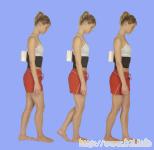Gait / Stairs / Slopes |
||
| |
||
| The underlying principle
for all balance testing during gait is to measure the functional ability of a
subject to integrate different aspects of sensory inputs into a unitary
balance command, especially when this ability is challenged. To judge
whether gait is normal gait or not, SwayStar™ provides reference data
of normal subjects, over the age range 6-82. |
||
| Gait, stairs and slopes tasks
involve more complex uses of sensory inputs and varied motor control. These tasks
naturally lead to an increase in trunk sway in subjects who have a balance deficit
when compared to normal subjects. There are four gait (one with barriers) and two
tandem walking protocols available as pre-defined protocols in Star™ on first
installation. The subject should start the task standing normally. When the task is
completed, the recording should be stopped. Otherwise only when the subject losses
|
||
All tasks should be performed with the aid of one or two assistants as "spotters" if the instability of the subject is such that there is a danger of falling during testing or the test subject has a fear of falling. |
||
| Gait tasks |
||

 |
Pre-defined gait tasks include: |
|
|
||
| Tandem steps tasks | ||
 |
|
|
| Stairs / Slopes | ||
Stairs (1 task is normally done)
Note: If there are handrails for the stairs, the subject should be instructed not to touch the handrails. If the handrails are touched during the protocol, it is to be interpreted as a fall and the protocol should be terminated. |
||
|
|
||
|
|
| [Installation] [Download] [Manual] [Reporting] [Publications] [Stance Tests] [Gait Tests] [About] |
|
|
| ©
2004-2012 Balance International Innovations GmbH 15.11.2012 |